The search for what causes SIDS
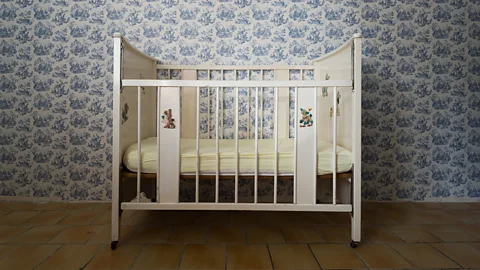 Andy Feltham/Getty Images
Andy Feltham/Getty ImagesSudden infant death syndrome kills thousands of babies every year. We don't yet know the cause of SIDS – or its cure. But researchers are getting closer.
It was three days before the twins' second birthday. When their mother, Carmel Harrington, put them to bed, she expected to be woken multiple times overnight by Charlotte. Her brother, Damien – a sweet, engaging toddler with a mop of brown curls and a passion for his toy motorbike – always slept more soundly.
This article contains content about baby loss that some readers may find upsetting.
Instead, Harrington rose the next morning feeling refreshed. But when she went into the twins' room, she encountered a parent's worst nightmare: Damien had died during the night.
For a parent, there are few scenarios more horrifying. And, despite 30 years of public health efforts, it is still one that becomes reality for thousands of families around the world every year.
In Australia, where Harrington lives, sudden infant death syndrome (SIDS) remains a leading cause of death for infants. Around 100 babies a year die suddenly and unexpectedly, usually in their sleep (a category called SUDI, or "sudden unexpected death in infancy", which includes SIDS, accidents such as suffocation or strangulation, and unknown causes). In the UK, around 300 babies die suddenly in their sleep each year.
In the US, SIDS, in particular, is the leading cause of death for infants from one month to one year old, causing the deaths of an estimated 1,389 babies in 2020. In the same year, another 1,062 infants died of unknown causes and a further 905 deaths were ruled as accidental suffocation or strangulation in bed.
Despite the personal tragedies that each of these cases represent, the overall numbers are often interpreted as relative success stories – they used to be much worse. In the US in 1990, for example, for every 100,000 live births, 155 infants were dying suddenly in their sleep from causes including SIDS. Ten years later, that rate had fallen to 94 per 100,000 live births. Similar declines were seen around the world.
But over the last 20 years, the decline has plateaued – in 2020, the rate was 93 infants per 100,000. And while in many countries improvements in healthcare, vaccines and improved drugs have helped to crack, and largely eradicate, a number of the other conditions that once killed thousands of small children – measles, mumps, polio, and whooping cough, to name a few – sudden overnight deaths largely remain a mystery.
Not only is there no "SIDS vaccine", SIDS itself is a diagnosis of exclusion. If there isn't a clear cause of death, SIDS often goes on the coroner's certificate.
We also don't know what causes SIDS.
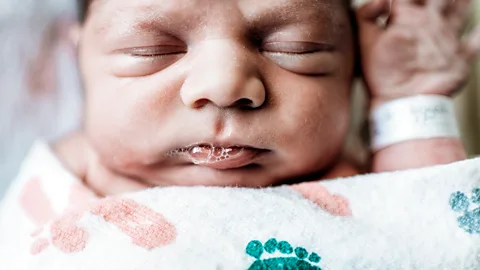 Cavan Images/Getty Images
Cavan Images/Getty ImagesFamily Tree: Sleep Specials
This article is part of a BBC Future series by Amanda Ruggeri on infant sleep. Read previous stories on the science of healthy baby sleep and what we really know about sleep training.
"For many years, we thought there was a thing called SIDS. That's not the working model right now," says Richard Goldstein, a leading SIDS researcher and paediatric palliative care specialist at Boston Children's Hospital and Harvard Medical School. "SIDS is a descriptor – it's a description of an outcome. And that outcome is that a seemingly well infant is placed to sleep and dies during their sleep for no apparent cause."
It's true that we know many of the ways that we can decrease the risk of sudden unexpected death in infancy.
This is why parents are told to keep their child up to date with vaccines, not to smoke, to room-share with their infants, to put babies to sleep on their backs, and to never sleep with their baby on a couch or chair, in soft bedding or while under the influence of alcohol or drugs. Among the other guidelines on reducing the risk of SIDS, parents are also advised to ensure a baby is never in a chin-to-chest position, which narrows their airway (as can happen in a baby-carrier, car seat or sleep nest), and not to overwrap their baby as it can cause them to overheat. Inclined sleeping products such as sleep nests and cot (or crib) bumpers were recently banned in the US due to the risk they pose, but remain on the market in other countries. One of the reasons mothers are also encouraged to breastfeed is that it is linked to a lower risk of SIDS.
Some of these guidelines come down to basic infant physiology. "The most important thing for your baby is to consider that what they need while they sleep is very important. It's different to what adults need while they sleep," says Anna Pease, a research fellow at the University of Bristol in the UK who studies ways of helping to prevent SIDS. "Infants are preferential nose-breathers. The first few weeks, they just breathe through their nostrils while they're asleep. Those are tiny, tiny little holes, and they have to get all of their oxygen for life through these tiny little nostrils. That's why they need a clear face.
"Okay, it's nice, they want to hang onto the teddy, or you've hung a muslin next to their face – take it away. It looks cute for you, but these nostrils are keeping them alive. Make sure that they're not getting covered in any way."
Babies and small children also overheat more easily than adults, which is why families are told not to overdress their children, but also to avoid commonplace behaviours like covering a pram for shade.
But when it comes to SIDS, in particular, minimising risk isn't the same as eradicating deaths – and understanding what raises SIDS risk isn't the same as knowing what causes it.
One review of 4,929 SUDI cases in the US, which included SIDS, found that nearly three-quarters occurred in a sleep environment with at least one risk factor. But that means more than one in four infants who died were in environments that seemed to have followed safe sleep guidelines to the letter.
Similarly, a child safeguarding practice review of all SUDI deaths, including SIDS, in England and Wales in 2018-19 found that "modifiable factors" were identified in 60% of the 325 cases; in 40% of cases, no such risk factors were found (which, it's worth noting, could also be due to an absence of information).
It is worth keeping in mind, too, what counts as a risk factor. In the US, for example, it means any deviation from a specific set of circumstances: where a child found on their back in a crib or bassinet with nothing else other than a safety-approved mattress and fitted sheet. Some cases categorised as presenting risk factors might be babies co-sleeping with a parent who had misused alcohol or drugs while others might be simply a baby on her back in a crib with a teddy bear nearby.
There's a further problem, too. "We don't have comparative data to show how many children with the same risk factors do not die – we don't understand the denominator," says Goldstein.
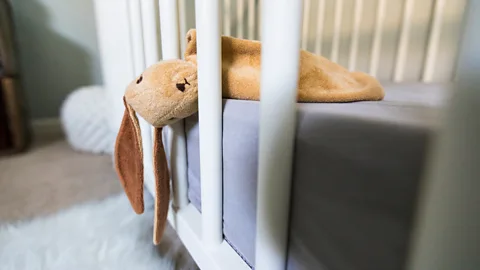 Cavan Images/Getty Images
Cavan Images/Getty ImagesHarrington, for one, had followed all of the safe sleep recommendations. To her, and to most SIDS researchers today, there had to be a reason why some babies in distress could rouse themselves, while others, like Damien, could not. (Technically, the diagnosis SIDS is now used only for infants under one. Damien's death today would be ruled "sudden unexplained death in childhood", or SUDC. But many researchers think that both the phenomena and causes could be similar).
"I couldn't understand why these babies don't wake up," Harrington says. "We've got really powerful survival mechanisms. A baby wakes us up pretty quickly when they're not happy."
Damien died in 1991. By 1994, Harrington, who already had a science degree with a major in biochemistry, had quit her job as an attorney to devote her career to researching SIDS. Last year, after more than 25 years, she was ready to give up. In December 2021, she was sure that her latest study, which looked at whether there was any association between a potential biochemical marker called butyrylcholinesterase (BChE) – an enzyme that plays a crucial role in autonomic functions like breathing and sleeping – and SIDS, wasn't going to find anything. She thought about retiring: spending her time painting, or honing her French.
Then she ran the numbers. In a sample size of about 700 babies, including 26 who died from SIDS, the SIDS infants had, on average, decreased BChE activity – as measured in dried blood spots taken two or three days after birth – compared to the babies who didn't die of SIDS.
Boosted by an enthusiastic press release, the findings ricocheted around the world. Headlines consistently oversold Harrington's study, claiming she'd found the "cause" of SIDS – or, alternatively, that a "cure" was imminent. Neither, sadly, is true.
"This is only a biomarker. It's not a cause," says Harrington. "At this stage, what it shows is an increased vulnerability. The study still has to be validated by an independent lab. But the world is so hungry for an answer because we just don't know which babies are going to die."
A modern epidemic
Babies dying suddenly overnight is a tragedy as old as history itself. One early literary reference dates back to the Old Testament story in which King Solomon resolves a dispute between two mothers over whose baby is theirs. One of the mothers had lost her child in the night because she "overlaid it". "Smothering" remained a potent fear for centuries.
In the 1800s, in Western countries, more families began to put infants in their own rooms. But babies kept dying. Not only that, but over the course of the 20th Century, rates in many countries skyrocketed – despite being lower in nations like Japan, where families often bedshared. It was clear something more than "overlaying" was happening. (In fact, we now know that an infant sleeping in their own room is associated with a higher risk of SIDS, which is why it's generally recommended to room-share.)
"In the late 1980s, when SIDS was much more common, it was about 1,500 deaths a year" in the UK, says Pease. "Everybody seemed to know someone, or know someone who knew someone, who had a baby die, with completely no cause found, in their sleep."
At first, the answer to what was happening seemed to lie in how babies were put down to sleep. In the Netherlands, for example, SIDS deaths more than doubled after parents were told to put babies to sleep on their bellies. It is now clear that putting babies to sleep on their belly, also known as the prone position, is associated with a far higher SIDS risk. This may be because it appears to impair an infant's arousal response – which would normally stir them if they had trouble breathing, for example – and also makes them more likely to overheat.
Countries started running public health campaigns, highlighting the importance of safe sleep guidelines. These campaigns are largely credited for halving SIDS rates, and the rates of SIDS infants found prone has dropped significantly. But while the campaigns were known as "Back to Sleep", this is oversimplistic: as well as telling parents to put babies down on their backs, they emphasised factors like not smoking, which is related to increased SIDS risk.
It's also notable that SIDS rates declined at the same time as infant mortality from other causes – a signal that more systemic changes, like more universal prenatal care, might have played a role.
Determining risk factors for SIDS is important. It's saved thousands of lives. But it doesn't get at the cause of SIDS, or provide a cure.
"My day job is dealing with families who have gone through this. On their behalf, and on mine, I'd say, 'Do everything you can'," Goldstein says. "But, as researchers who want to eradicate SIDS, we want to know what the terminal cascade is so we can directly address it."
 ArtMarie/Getty Images
ArtMarie/Getty ImagesWhat to know about SIDS
Sudden infant death syndrome (SIDS) is defined as the sudden, unexplained death of a seemingly otherwise healthy baby, normally during sleep (including naps). It remains a leading cause of death for infants around the world.
SIDS sits within a broader category called SUDI, or "sudden unexpected death in infancy", which includes SIDS, accidents such as suffocation or strangulation, and unknown causes. Because determining whether a baby died from SIDS or an accident such as suffocation can be complex, it is common to look at the overall rate of SUDI to see whether rates are getting better, or worse.
In countries including the US, after a sharp decline in SUDI rates in the 1990s, the rate of SUDI has plateaued.
Researchers are still determining what causes SIDS. The hope is that the more we can understand about what causes SIDS, the more it can be prevented from happening.
The SIDS puzzle
There are a variety of reasons that SIDS has been so hard to untangle. One is that it happens during sleep, where an infant is usually unobserved.
Another is how SIDS has been categorised. In the earlier days of tracking SIDS mortality, medical examiners often categorised the death of a baby during sleep as SIDS. Now, the classification is more precise, which means some of the decline in SIDS might be an artificial statistical effect (although researchers point out that, again, the fall and plateau in sudden unexpected death mirrors that of overall infant mortality, so this effect is unlikely to play a large role on its own).
Currently, says Pease, in countries including the UK and US, a SIDS death is defined as one where – even after a post-mortem, assessment of clinical history, and investigation of the circumstances – there's no concrete cause of death.
But even in those cases, many pathologists feel more comfortable with the term "unascertained", saying they feel that SIDS implies a single, unknown pathological factor. This means SIDS rates could be under-reported.
There may be more SIDS cases than we think for other reasons, too. If a baby is found lying on their belly, for example, many pathologists will diagnose the cause of death as something like "positional asphyxia", not SIDS – even though most children in that circumstance will rouse and reposition themselves, says Torleiv Ole Rognum, a forensic scientist and a leading SIDS researcher at the University of Oslo, in Norway.
Or, as Goldstein and others wrote in a recent article, medical examiners often say the cause of death was "suffocation" if they see a sleep-related risk factor on the scene – such as a blanket or pillow – even though there's no physical evidence that the infant had obstructed breathing.
The investigation process also varies from country to country. In Norway, says Rognum, a full autopsy is performed within 48 hours of death, including one particularly important element – microbiology. In the UK, by comparison, it takes a week to have a medical autopsy and a month to complete a forensic autopsy. "That is strange," he says. "What can you find after one month by autopsy? We have shown that you can't trust microbiology more than 48 hours after death."
Furthermore, Goldstein and others write, sudden infant deaths are evaluated outside of the institutions that investigate undiagnosed diseases. Often initially treated as criminal investigations, they receive forensic autopsies, which don't involve techniques such as advanced phenotyping and molecular research that are used for clinical diagnoses. This is despite the fact that SIDS is "the ultimate undiagnosed disease", Goldstein says.
"Along with failing to respond to families' emotional pain and confusion, we permit postmortem assessment to focus primarily on the legalistic question of manner of death, rather than on the medical question of biologic and environmental causes," they write. "The current approach may answer questions about mistreatment, but it leaves any effort to know more about etiologic factors, including possible risks to siblings, to bereaved family members. Medicine doesn't exhaustively attempt to explain these deaths, even though doing so would be routine in other disease areas."
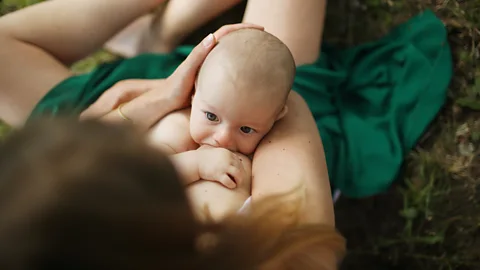 Catherine Delahaye/Getty Images
Catherine Delahaye/Getty ImagesAll of this has made it more difficult to get a representative sample of SIDS deaths. It is a challenge heightened by the sensitivity of the research process, particularly in studies that look at tissue or blood samples, such as in the research conducted by Harrington, since parents need to consent to be involved.
And because research relies on parents who feel "able or interested in" contributing, says Goldstein, white, Western and relatively wealthy families are overrepresented. That's even though the risk of SIDS is far higher among families with lower socioeconomic status, and even though, in countries including the UK, the socioeconomic difference in the probability of a child suddenly dying in infancy is getting worse.
"The sociodemographics of the children most at risk for SIDS are the sociodemographics of those least likely to participate," he says. "It is also fair to say that they are the sociodemographics of the people most likely to receive harsh treatment and suspicion during the response to their child’s death." Like all sudden and unexpected deaths, cases of SUDI are initially treated as a suspicious from the outset, meaning the first step is to rule out any wrongdoing on the part of the caregivers.
Then there is the relative lack of research funding. At the US National Institutes of Health, the world's largest source of medical funding, SIDS is one of the most underfunded paediatric areas of research.
Even with these hurdles, however, researchers are getting closer to understanding SIDS.
Getting closer
Despite the widespread coverage, Harrington was not the first researcher to find a potential "SIDS biomarker". Nor are we completely clueless about what potential causes might be.
First, there's another reason why, over the years, SIDS deaths have declined: we have found why some of these infants are dying. That hasn't just chipped away at what's being categorised as SIDS. It means that, in some cases, we've been able to prevent those deaths.
Take fatty-acid-oxidation disorders (FAOD), genetic defects that disrupt the body's ability to produce energy and can make fasting lethal in a matter of hours. We now know that up to 5% of deaths once categorised as SIDS were caused by FAOD.
Today, newborns are routinely screened for the most common FAOD, medium-chain acyl-CoA dehydrogenase deficiency (MCADD), which affects one in 20,000 infants of Northern European descent.
Newborn screening is not a panacea. But in the case of MCADD, a rare condition where the body can't efficiently break down fat for energy and which can be especially dangerous if the person goes for a spell without eating, it has saved lives. Rognum remembers one small child who died after she had been vomiting for just a few hours. The autopsy disclosed a MCADD mutation as well as liver disease, the likely result of MCADD. "That shouldn't happen anymore," he says. "If we know about that [MCADD] diagnosis, we will take care that that child will not get hypoglycaemic, and they will not die.
"I think we will find more such explainable causes. Then they have to be excluded from the SIDS 'cake'," he adds.
Most researchers still believe, though, that even as more accurate diagnoses of diseases like MCADD help to offer explanations for some deaths that would have been otherwise classified as SIDS, it will never be the whole story.
There is a core phenomenon shared by many infants dying from SIDS. And it has to do with their arousal from sleep.
This theory emerged in the 1980s, when hospitals began to use medical monitors for newborns, including those who died of SIDS under medical care. By looking at this new data, researchers started to notice that the SIDS infants had had different sleep patterns. In particular, babies who went on to die from SIDS both moved less and had fewer spontaneous arousals, or episodes of stirring and waking.
When they looked back at the data of babies in the moments before they died of SIDS while on monitors, researchers also saw something else.
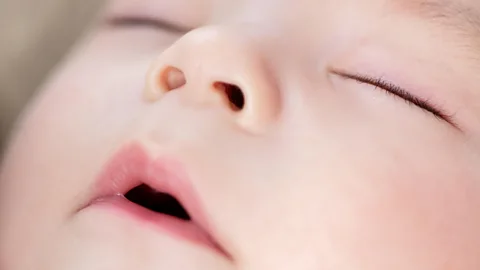 Lev Dolgachov/Alamy
Lev Dolgachov/AlamySafer sleep for babies
While we can't be sure exactly what causes SIDS, we know that certain sleep practises are associated with a higher risk of babies dying during sleep. This is why the following is recommended for every sleep, including naps, from the UK's Lullaby Trust:
When a healthy baby experiences either too little oxygen or too much carbon dioxide, explains Goldstein, their breathing halts (an "apneic pause") before they start to gasp. "Those gasps, usually, in a healthy baby, will cause the heart rate to come up," Goldstein says. "Those babies arouse, and arousal-related reflexes occur: they arch, they yawn, they turn, they wake up and cry, and that frees most babies from relatively modest obstructions and they survive.
"And the SIDs babies didn't do that. They didn't arouse and they stayed 'uncoupled' between these agonal gasps, which are driven by certain centres of the brain, and the cardiac response."
That means a "vicious circle" where the feedback system doesn't function, ending in a coma and death, says Rognum.
Why? In Norway, Rognum, together with paediatrician and neuroscientist Ola Didrik Saugstad, came up with the theory of the "fatal triangle", which they defined as "a vulnerable period after birth, some genetic predisposition, and a trigger event". In the US at around the same time, a team led by Goldstein and Hannah Kinney of Boston Children's Hospital came up with a similar idea: the "triple risk model".
It's the latter label that caught on, and it's this theory that is now the leading explanation among SIDS researchers. It gets to the heart of what scientists have suspected since at least the 1970s: SIDS is not caused by a single event, but several factors coming together. "There's not just a single reason," says Goldstein. "We put it more in the category of an expression of a rare undiagnosed disease where at least some of the time, at its initial presentation, it is incompatible with survival."
Rognum had noticed that the highest-risk period for dying of SIDS, between the second and the fifth month after birth, is also a period where the immune system rapidly develops. "When something develops very rapidly, it's also unstable," he says. That's the vulnerable period after birth. A trigger event could be a seasonal respiratory infection or sleeping prone, or both together – a pairing which increases the risk of SIDS 29-fold. (Rognum points out, thought, that often contrary to popular belief, the risk of SIDS in the earlier versus the later months of life is less dramatic than it once was, and deaths remain a risk after the five month mark.)
It is what the "predisposition" is, though, that may be the most enduring puzzle at the heart of SIDS. In recent years, however, this aspect too is becoming less of a mystery.
Researchers including Kinney have thought it might be an issue with the serotonergic system – the neurotransmitters centred in the brainstem that regulate a number of automatic processes, including sleep and breathing. Over the last 20 years, Kinney's team have honed their hypothesis through multiple studies. An elevation of serotonin (5-HT) in the blood, in particular, is a biomarker for SIDS in around 30% of cases. And their findings have been corroborated by other teams. One study of autopsies, for example, found that serotonin levels were 26% lower in SIDS cases than in healthy infants – a biomarker discovered before Harrington's finding.
Similarly, Rognum thought the genetic element could be due to varients, or polymorphisms, in the genes that make interleukins – which can be either anti-inflammatory, or pro-inflammatory molecules. They are usually produced in response to damage caused by infections or injuries, so variants in these genes can make this part of the immune response weaker or stronger than they should be.
"We found in the cerebral spinal fluid that the SIDS cases had significantly higher levels of interleukin-6. That's the interleukin that gives us fever," Rognum says. "Half of the SIDS cases have levels in the same range as children that died from meningitis and septicaemia, without having those diseases."
In one study, Rognum, Kinney and other researchers, examined how both of these findings might come together, looking at whether SIDS infants were more likely to have a compromised serotonergic system that changed how interleukin-6 receptors were expressed.
The answer was yes. In particular, the study showed that – in the part of the brainstem involved in protective responses to carbon dioxide accumulation – the infants showed abnormal interleukin-6 receptor expression. Carbon dioxide accumulation, of course, can be a result of rebreathing due to, say, sleeping prone.
"Are SIDS infants 'normal' infants who accidently die by suffocation?" Kinney and other researchers write in another study. "Rather, the brainstem research suggests that they have an underlying vulnerability in the serotonergic alarm system that makes them susceptible to sudden death, that is, the triple risk model."
Researchers have even demonstrated the same effect in mice pups: if serotonergic transmission is inhibited, the pups are less likely to recover from apnoea – where breathing suddenly stops during sleep – caused by a lack of oxygen and are more likely to die. It's a sequence that is identical to the one researchers saw in recordings from sleep monitors of infants who died from SIDS.
Other DNA defects also have been implicated. A variant of the gene SCN4A, for example, which impacts the function of the respiratory muscles and is seen in some neuromuscular disorders, has been associated with a higher risk of SIDS.
But while there is a genetic element to SIDS for some babies, there is no "SIDS gene". One study found that the genes associated with known diseases that seem to contribute to sudden infant death make up about 11% of known cases, while another found it could be 20%. Both are significant numbers, but far from explaining every death. There also seems to be a link between SIDS and epilepsy.
While babies who die of SIDS are more likely to show these conditions or biomarkers, not all do. And while these biomarkers are sometimes present in children who die of SIDS, they also can be found in children who don't.
The triple-risk model remains more of a description than an actual explanation of SIDS. It's still unclear why some babies are born with these issues and others aren't. And, perhaps most crucially to parents, beyond reducing risk factors in the sleep environment, it is still hard to know how to translate this wider information into saving babies.
"Testing for serotonin during autopsy has never been generalised into clinical care," says Goldstein. "Nobody really knows what to do with it. It's complicated science – it hasn't been turned into clinically applicable testing."
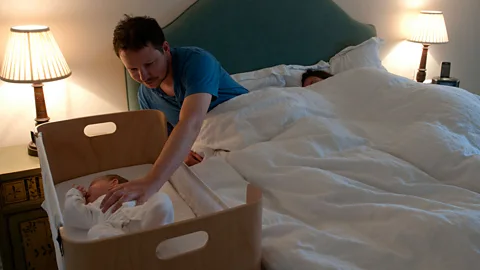 Jennie Hart/Alamy
Jennie Hart/AlamyThis gets at the issue with what to do with SIDS biomarkers in general. Researchers including Kinney have written that the hope is that the information can be used to screen and prevent deaths using "neural biomarkers and brain-related treatment strategies".
But we aren't there yet. Take Harrington's potential finding of lower levels of BChE activity in infants who died of SIDS. It could be an indicator of a problem with breathing or other autonomic functions. While the average level of BChE activity differed between the babies who died of SIDS and the controls, the ranges of BChE between the groups overlapped, meaning it could be difficult to pinpoint exactly what BChE level could point to a problem, if any.
Even assuming there is a level that could be used to identify a potential issue, what is then done with that information is an ethical dilemma. All parents are already told to follow safe sleep guidelines. The "brain-related treatment strategies" Kinney mentions do not yet exist. In the absence of further advice for parents whose children could be vulnerable, and with the fact that most children that have these biomarkers will not die of SIDS, you may be terrifying families unnecessarily. With no one single cause, SIDS remains a tragic combination of factors.
But neither is SIDS a complete mystery. Not only that, but the more we find out about it, the more we know that safe sleep habits – while crucial – aren't the whole story.
That knowledge is important, not just so we can get closer to eradicating SIDS, but also for the families who often are dealing with shame, blame and guilt on top of their grief, says Goldstein, who has worked with hundreds of bereaved families over the course of his career.
He points to the fact that only around 18% of SIDS deaths have enough evidence to support suffocation, or that SIDS deaths are much more likely to happen in day care centres than in family homes – even though infants in childcare are no more likely to be found prone or be on an unsafe sleep surface than those in the care of their parents.
"There is this innuendo of neglect, and maybe sometimes that's the case," Goldstein says. "But SIDS is not the story of parents who aren't listening to their doctors and ignoring advice."
Even where cases involved a situational risk factor in which caregivers didn't follow all of the safe sleep guidelines, according to the child safeguarding panel review of SUDI incidents in England, "in none of the [14 reviewed] cases was there any suggestion that the parents had intended any harm to their child – on the contrary, most of these parents come across as devoted, loving and caring as any other parent." The panel recommended, however, that as well as informing parents on what to do, guidelines should also explain why. For example, explaining how infant's tiny airway can become constricted if they are sleeping chin-to-chest.
Peter Sidebotham, the panel lead for the report, added that factors out of a family's control can wind up being risk factors, too. A health visitor may not have delivered safe sleeping advice to parents, for example, or a family could have been evicted from their home and ended up in temporary or unsuitable accommodation.
But blaming caregivers is a story as old as the story of sudden infant death itself. Take the Old Testament tale of the two mothers mentioned earlier. "There is no sympathy for that other woman," says Goldstein. "You could easily have imagined that it was an explanation of the depths of despair of losing your child. But she's just cast aside in the story."
This comes back to the central argument that he, and other researchers, share: it's important to keep educating parents on safe sleep. But identifying risk factors will never be a silver bullet. To find a cure for SIDS, science first needs to nail down its cause.
"We're not there yet. We're nowhere near there," says Harrington. But she can now count her own contribution among the research on SIDS and the long path to finding answers.
"If you ask me what my hope is, my hope has always been, since Damien died, being able to do something at the newborn stage, and that we can screen, and protect. That's always been my hope. This finding has made me more hopeful."
* Amanda Ruggeri is a science and features journalist. You can find her at @amanda_ruggeri.
--
